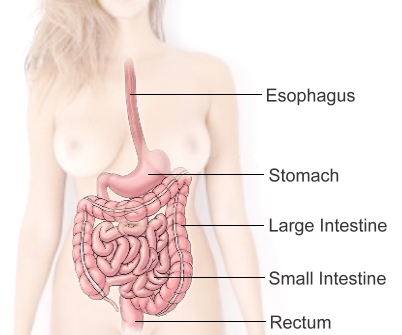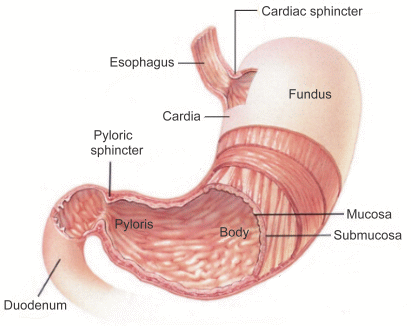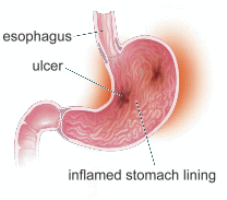
 Your stomach sits in your upper abdomen on the left side of your body. The top of your stomach connects to the esophagus; the bottom of your stomach connects to your small intestine.
Your stomach sits in your upper abdomen on the left side of your body. The top of your stomach connects to the esophagus; the bottom of your stomach connects to your small intestine.
The size of the stomach varies; it expands when full and deflates when empty. Because of this, your stomach size can vary depending on how recently and how much you have eaten.
The stomach digests food. It produces enzymes (substances that create chemical reactions) and acids (digestive juices). This mix of enzymes and digestive juices breaks down the food you eat so it can pass into your small intestine.
Your stomach has five distinct sections:

- The cardia is at the top. It contains the cardiac sphincter, which prevents food from traveling back up your esophagus.
- The fundus is a rounded section next to the cardia, below your diaphragm.
- The body is the largest section of your stomach, which contracts to mix the food.
- The antrum lies below. It holds food until your stomach is ready to send it to your small intestine.
- The pylorus is the bottom part. It includes the pyloric sphincter, which controls when and how your stomach contents move to your small intestine.
Several layers of muscle and other tissues make up your stomach:
The mucosa is your stomach’s inner lining. When your stomach is empty, the mucosa has small ridges. When your stomach is full, the mucosa expands, and the ridges flatten.
The submucosa contains connective tissue, blood vessels, lymph vessels and nerve cells. It covers and protects the mucosa.
Your stomach is part of the gastrointestinal tract. The GI tract is a long tube that starts at your mouth. It runs all the way to your anus, where stool leaves your body. Your stomach’s purpose in the GI tract is to digest food and send it to your small intestine. Its three functions include:
- Temporarily store food.
- Contract and relax to mix and break down food.
- Produce enzymes and other specialized cells to digest food.
The stomach lining produces gastric acid, a watery, colorless fluid that is highly acidic and helps break down everything from meat to tough, fibrous plants for easier digestion. It is a combination of hydrochloric acid (HCl), potassium chloride (KCl) and sodium chloride (NaCl). This liquid has a pH level of 1, on a scale from 0 to 14, (battery acid's pH is 0).
The cells lining your stomach wall secrete this liquid, as well as several enzymes and mucus. The mucus protects the lining of your stomach so that the acid and other gastric juices don’t damage the organ.
During the digestive process, your body absorbs nutrients and water. Then you expel the waste products of digestion through your large intestine.
The parts of the gastrointestinal tract:
- Mouth: As you chew and swallow, your tongue pushes food into your throat. A small piece of tissue called the epiglottis covers your windpipe. The epiglottis prevents choking.
- Esophagus: Food travels down a hollow tube called the esophagus. At the bottom, your esophageal (or cardiac) sphincter relaxes to let food pass to your stomach. (A sphincter is a ring-shaped muscle that tightens and loosens.)
- Stomach: Your stomach creates digestive juices and breaks down food. It holds food until it is ready to empty into your small intestine.
- Small intestine: Food mixes with the digestive juices from your intestine, liver and pancreas. Your intestinal walls absorb nutrients and water from food and send waste products to the large intestine.
- Large intestine : Your large intestine turns waste products into stool. It pushes the stool into your rectum.
- Rectum: The rectum is the lower portion of your large intestine. It stores stool until you have a bowel movement.
Common conditions that can affect your stomach include:

- Gastric ulcers: Erosion in your stomach’s lining that can lead to pain and bleeding.
- Gastritis: Stomach inflammation.
- Gastroesophageal (acid) reflux disease: When stomach contents travel up to your esophagus, causing heartburn or coughing.
- Gastroparesis: Nerve damage that affects your stomach’s muscle contractions.
- Indigestion (dyspepsia): Discomfort, pain or burning in your upper stomach.
- Peptic ulcer disease: Ulcers (sores) in either your stomach or the first portion of your small intestine (duodenum).
- Stomach cancer: When cancerous cells grow uncontrollably in your stomach.
You can make lifestyle changes to keep your stomach and digestive system healthy:
- Drink alcohol only in moderation.
- Drink at least 50 ounces of water daily, depending on your activity level and size.
- Eat 25 to 35 grams of fibre daily, depending on your age and sex.
- Exercise regularly.
- Limit your intake of processed foods.
- Manage stress.
- Quit smoking or using other tobacco products.
Resources
HTML & design by Bill Willis 2023
|

 Your stomach sits in your upper abdomen on the left side of your body. The top of your stomach connects to the esophagus; the bottom of your stomach connects to your small intestine.
Your stomach sits in your upper abdomen on the left side of your body. The top of your stomach connects to the esophagus; the bottom of your stomach connects to your small intestine. 
